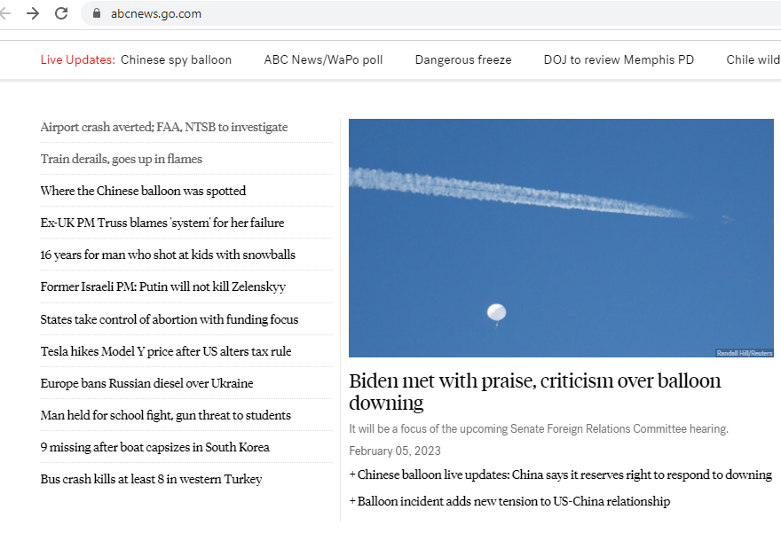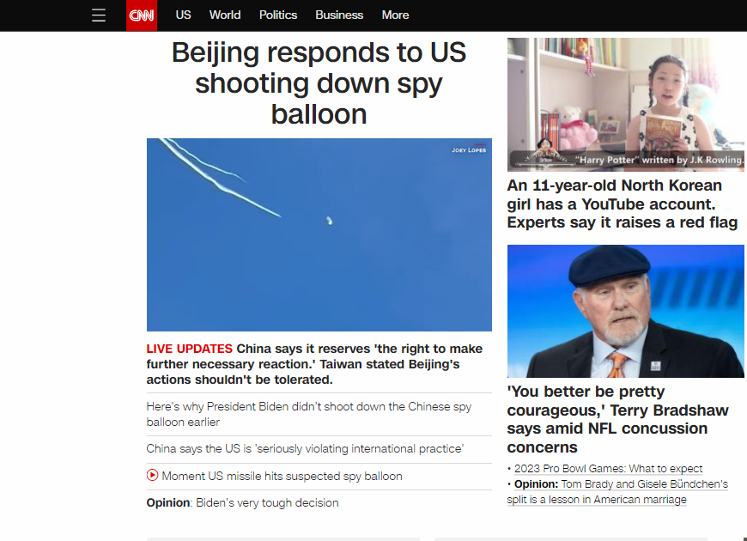The Cable News Network, famously referred to as CNN, is an American 24-hour news cable focusing on the events happening in the United States and worldwide. It is owned by Turner Broadcasting, owned by Time Warner. On the other hand, American Broadcasting Company, commonly known as ABC News, is owned by a Disney Company division. It is also a 24-hour news cable reporting on events happening in the United States and around the world. Kunst’s (2022) contribution to statistics identifies that people aged between 50-64 years mostly watched ABC News 81.6% in 2018 compared to 65.48% of people aged 18-29 years. On the other hand, 28% of individuals aged 50-64 are the most viewers of CNN.
CNN’s top news is providing live updates on the Chinese response to the United States’ action of shooting down the Chinese spy balloon in United States space. According to the story, the Americans were not supposed to shoot down the balloon. Thus, the Chinese say they deserve to respond. The second top story is an 11-year-old girl’s YouTube account in North Korea. According to the story, the channel may be fake, created by the government to create a picture that the country is friendly, contrary to the constant talks about nuclear weapons. The third top story is about Terry Bradshaw’s response to the increased concerns about concussions among NFL players. Similarly, ABC news has the Chinese balloon story updates as its main feature. The second story is about the near crash at the Austin airport where two airplanes nearly collided at the runway. The accident occurred when a cargo airplane was landing, and an international flight was cleared to depart from the same runway. The third top story is about a train derailing in flames in Ohio, causing half the town to evacuate. This is because the train is believed to have been carrying hazardous material. Fifty fire departments across three states responded to the fire.
According to the agenda-building theory, news outlets, journalists, and newsrooms select the events they feature as their top stories over others (Shah et al., 2009). This is true based on the main stories on both newsrooms’ top story is about the Chinese balloon flight over the United States and Biden’s response. However, the second and the third stories are different, confirming the theory that the newsrooms’ are the ones who decide which story is their top story. On the other hand, the framing theory argues that how such newsrooms present their story influences their audiences’ response and behavior toward the news feature (Shah et al., 2009). For example, though both stories feature American responses to the Chinese balloon spotted in the United States, they are different in how they are framed. ABC News reports that “Biden met with praise, criticism over balloon downing” as their headline for the story, whereas CNN’s headline is “Beijing responds to the US shooting down spy balloon.” Aside from these differences, there are similarities in the story as both news features are live updates of the Chinese balloon spotted in the United States.
In both newsrooms, their main story takes the most significant part of their homepage. However, CNN provides pictures for the other top stories, unlike ABC, whose top stories are in a list besides the top stories. This is an effective approach because one page has many links to its top stories compared to CNN, whose pictures are many, and links to the news feature fewer. Both newsrooms are the same in the arrangement of their home pages where scrolling down trending stories are classified under different categories, for example, politics or crime and investigation, as they know the preferences of their audience.
Ries et al. (2023) feature a story on CNN about a derailed train in Northeastern Ohio that caused a blaze in the surrounding area. This story is among the headlines in the category of the United States, whereas in ABC news, it is among the top stories. The media has framed these two stories differently, evidenced by their headline and the details of the news feature. For example, for CNN, the headline is “Train derailment in northeastern Ohio sparks massive fire.” On the other hand, ABC’s headline is “Train derails, goes up in flames in Ohio, causes half of the town to evacuate” (Charalambous, 2023). The second one is more detailed and eye-catching, especially when evacuating half the town. There is a big difference in how the two stories were framed; for example, CNN includes an EPA report about the smoke, whereas ABC is more concerned with the eye-witnesses and the impact of the fire on their lives. Therefore, ABC chooses to tell the story from the locals’ perspective, while CNN tells from an expert angle where the news argues that the smoke had no health impacts on the locals. This is contrary to what is reported by ABC, where the locals reported a burning sensation in their eyes and throats due to the smoke. The quotes incorporated by Ries et al. (2023) were from leaders and experts in the field of fire, whereas Charalambous (2023) incorporated quotes from experts in the field and one of the residents. There was no bias in reporting as the two articles had relatively similar details, especially the people affected by the cause of the fire, the response, and the state by the time the article was written.
The general tonality is different from other stories from the two media houses. CNN tends to be more negative compared to ABC. This is because, as observed, some of the news tends to be on the negative side; for example, a story about pills in the United States news feature reported especially on how it had affected millions of Americans. This is different from ABC because their features have hope hence the conclusion of a positive tonality. CNN frames its story more generalized than ABC, which provides specifics. CNN’s story angle is more on the effects than ABC, which is more on the particular event-making headline. CNN has more visuals that magnify the issue compared to ABC. Both newsrooms provide quotes, especially from relatively reliable sources.
Conclusively, according to the agenda-setting theory, newsrooms provide their audience with what to think about. This is evidenced by their top stories depending on what they believe will interest their audience. On the other hand, according to the framing theory, newsrooms tell the audience what to think about. This is evidenced by how the stories are written, including what is incorporated in the stories, especially the sources, pictures, and videos, among other features that influence how people perceive the information. Both the featured media houses conform to these theories, which is why they attract people from different age groups.
ABC News and CNN News Home Page


References
Charalambous, (2023). Train Derails, Goes Up In Flames In Ohio, Causes Half of Town To Evacuate. https://abcnews.go.com/US/train-derails-flames-ohio-causes-half-town-evacuate/story?id=96892580
Rebekah Riess, Hannah Sarisohn, and Christina Maxouris, (2023). Train Derailment in Northeastern Ohio Sparks Massive Fire. https://www.cnn.com/2023/02/04/us/east-palestine-ohio-train-derailment-fire/index.html
Shah, D. V., McLeod, D. M., Gotlieb, M. R., & Lee, N. J. (2009). Framing and Agenda Setting. The Sage Handbook of Media Processes and Effects, 83-98. https://books.google.com/books?hl=en&lr=&id=CMO1aEWrzacC&oi=fnd&pg=PT91&dq=Framing+Theory+and++Agenda+Setting+Theory&ots=sBoDSr0dAI&sig=gLa9StiGrdZi1dIegtQHRLJTpTQ
 write
write